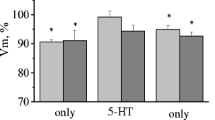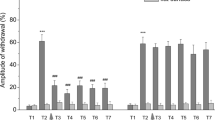Conclusions
-
1.
Regular tactile stimulation of the snail's foot causes a temporary increase (to the second stimulus), followed by a decrease in amplitude of the unconditioned reflex of pneumostome closure.
-
2.
Of all identified neurons studied, only the responses of the command neurons of the defensive reflex of pneumostome closure were increased to the second stimulus in the series, whereas responses of nerve cells participating in the processing of sensory information decreased steadily. Sensitization of responses of the command neurons is evidently a mechanism of behavioral sensitization.
-
3.
The cause of sensitization of the command neurons is long-lasting depolarization in response to tactile stimulation, arising after the spike discharge of the cell and facilitating responses to subsequent stimulation.
Similar content being viewed by others
Literature cited
P. M. Balaban and E. G. Litvinov, Zh. Vyssh. Nerv. Deyat.,27, No. 3, 538 (1977).
E. G. Litvinov and P. M. Balaban, in: Structural-Functional Analysis of Brain Activity [in Russian], Nauka, Moscow (1973), p. 73.
E. G. Litvinov and P. M. Balaban, Zh. Vyssh. Nerv. Deyat.,23, No. 6, 1313 (1973).
D. A. Sakharov, The Genealogy of the Neuron [in Russian], Nauka, Moscow (1974).
E. N. Sokolov, in: The Pacemaker Potential of the Neuron [in Russian], Metsniereba, Tbilisi (1975), p. 7.
P. M. Groves and R. F. Thompson, Psychol. Rev.,77, 419 (1970).
P. M. Groves and R. F. Thompson, in: Habituation: Physiological Substrates, Vol. 2, Academic Press, New York (1973), p. 240.
E. R. Kandel, in: Neurosciences: Third Study Program, edited by O. F. Smitt and F. G. Worden, MIT Press (1974), p. 347.
K. Krnjevic, R. Pumain, and L. Renaud, J. Physiol. (London),215, 247 (1971).
C. A. G. Wiersma, Proc. Soc. Exp. Biol. (New York),38, 661 (1938).
C. A. G. Wiersma and K. Ikeda, Comp. Biochem. Physiol.,12, 509 (1964).
R. S. Zucker, J. Neurophysiol.,35, 621 (1972).
Author information
Authors and Affiliations
Additional information
This article is based on a paper read at the International Symposium on “Neuronal mechanisms of brain integrative activity” in Moscow, in May, 1976.
Translated from Zhurnal Vysshei Nervnoi Deyatel'nosti, Vol. 28, No. 2, pp. 356–362, March–April, 1978.
The author is grateful to E. N. Sokolov, under whose direction this investigation was undertaken.
Rights and permissions
About this article
Cite this article
Balaban, P.M. Sensitization and habituation in command neurons of the defensive reflex inHelix lucorum . Neurosci Behav Physiol 10, 340–345 (1980). https://doi.org/10.1007/BF01184047
Received:
Issue Date:
DOI: https://doi.org/10.1007/BF01184047




